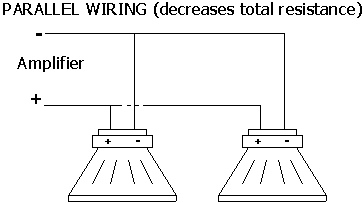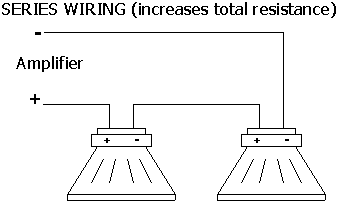A trick that professional installers use to get more power out of amplifiers is to wire up speakers in different ways, playing with resistances to achieve a desired total impedance “seen” by the amplifier. Even though speakers are active loads (resistance changes with frequency), it is accepted to treat speakers as resistors with a fixed resistance value (usually 4 ohms).
By combining speakers in different ways, maximum amplifier output can be obtained. For example if a 2-channel amplifier is rated to deliver a maximum output of 400 watts at 2 ohms mono (bridged), then by hooking up two 4 ohm subwoofers in parallel, a total load of 2 ohms is “seen” by the amplifier, obtaining optimum power.
Parallel Resistance

People commonly hook up two or more speakers to the same channel out of an amplifier in parallel. This is achieved by hooking up the negative wire from the amp to all the negative connections of the speakers, and the positive to all the positive connections of the speakers. By doing this, the load seen by the amplifier is lower. For example, if two 4-ohm speakers are wired-up in parallel, then their total resistance will be half, or 2 ohms. If three speakers are wired up in parallel, and they all have the same resistance value, then the total load would be a third of the value of each speaker’s resistance. Here’s a formula to calculate parallel total resistance for two speakers:

For more than two speakers, use the following formula:

So what are the advantages and disadvantages of this scheme? First, if one of the speakers burns out, then the other one(s) keep playing. If the amplifier is not designed to receive lower loads provided by hooking the speakers up in this fashion, you might end up destroying your amplifier. Check your manual or consult an expert.
Series Resistance

Speakers are hooked up in series to decrease total load to an amplifier. To hook up speakers in series, connect the positive terminal of the amplifier to positive of one speaker, then hook up negative of that speaker to positive of next speaker, and so on. Then hook up negative of last speaker to negative of the amp. It is a lot easier to calculate total resistance for speakers hooked up in series. This is easily done by adding up all the individual resistances:
![]()
The disadvantage of hooking up speakers in series other than getting less power out of an amplifier, is that if one of the speakers burns up, the other one(s) stop working.